Arctic (2010)
Expedition to the Top of the World
Departing from Svalbard, an island archipelago in the Arctic Ocean, our Russian
research ship carried us north of the 80th parallel to within 600
miles of the North Pole before working its way southward along the coast of
Greenland to our final destination in Iceland. Our spectacular Arctic cruise
was bracketed by visits to old friends in both Norway and Iceland.
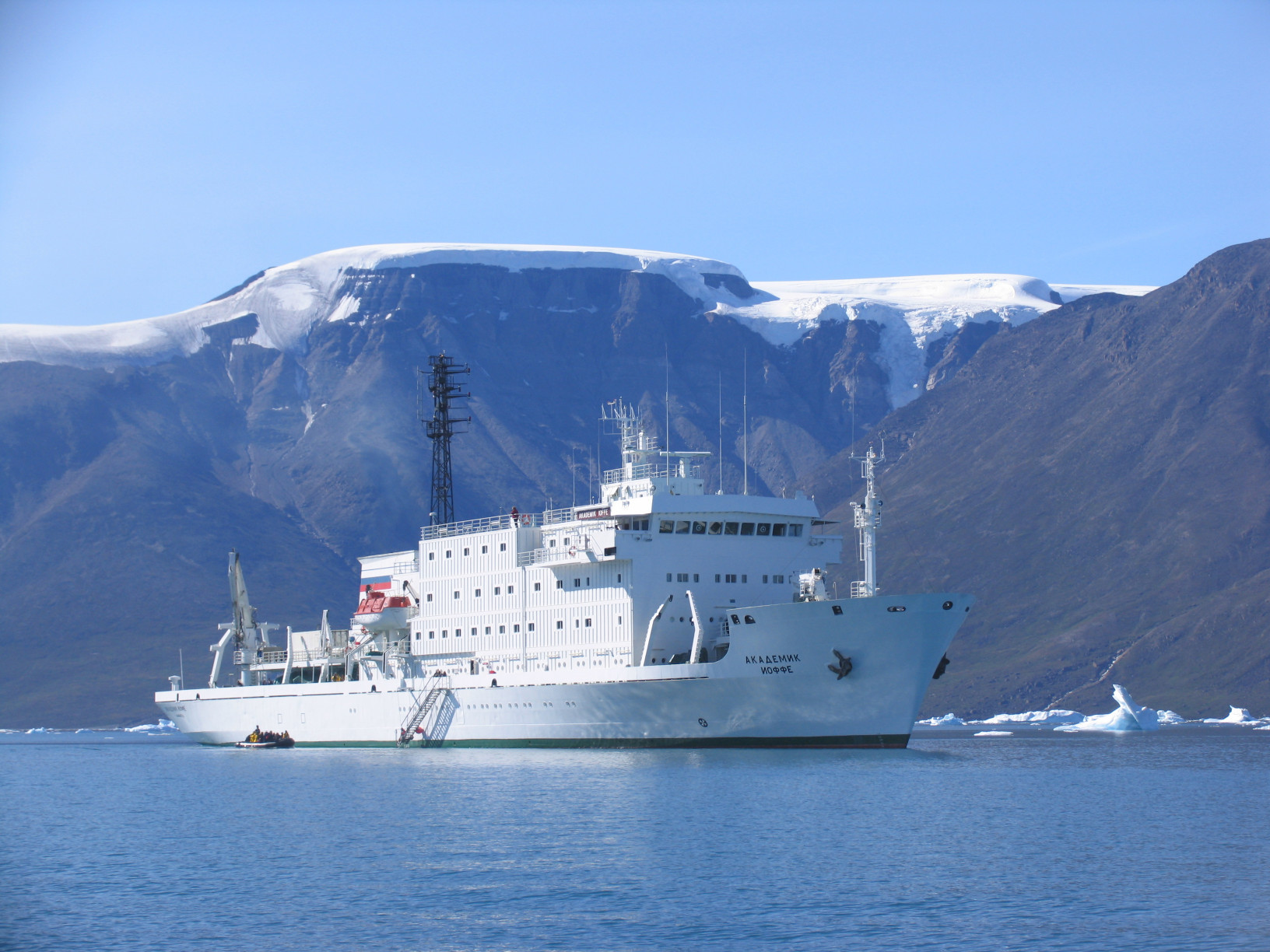
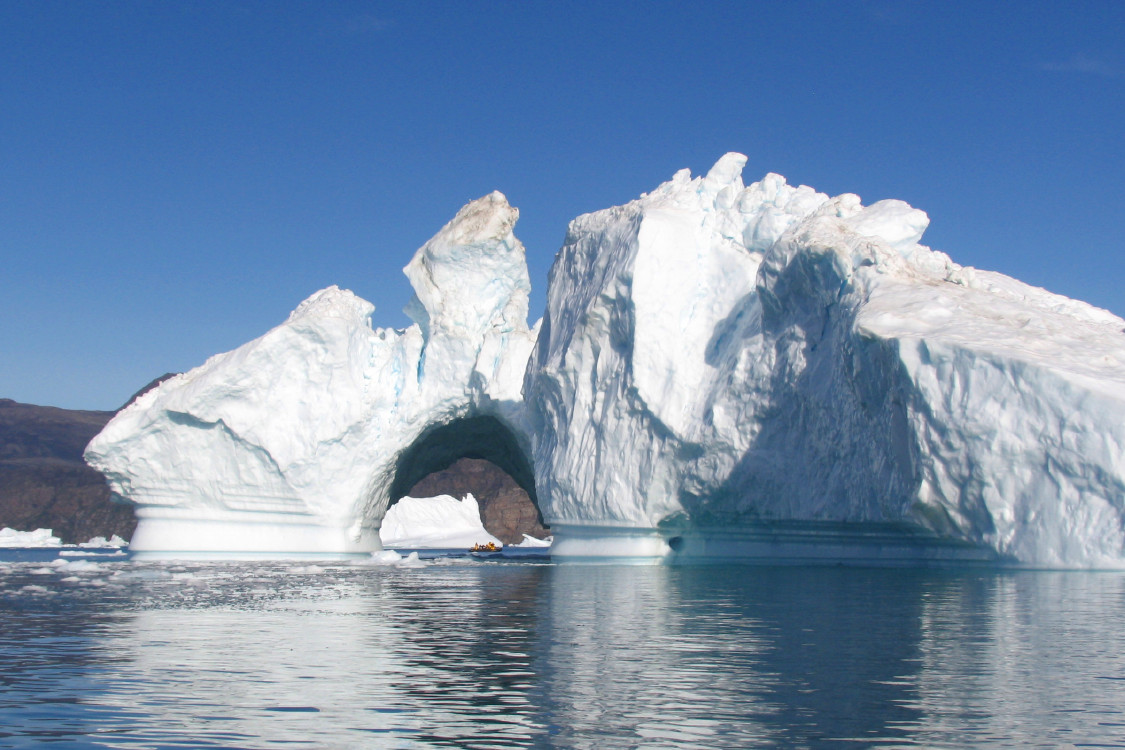
Akademik Ioffe
East Greenland Icebergs
Svalbard.
We had traveled to the Bottom of the World ten years ago when we visited
Antarctica and so it was just a matter of time before we set off to visit the
Top of the World as well. The two Polar Regions are totally opposite.
Antarctica is a continent surrounded by an ocean; the Arctic is an ocean
surrounded by continents. Antarctica is the land of penguins, seals and
albatross; the Arctic is the land of polar bears, walruses and reindeer.
Antarctica has no permanent population; the Arctic has been populated for over
20,000 years. And the bathtubs drain in opposite rotations at the two poles, or
so they say.
Following a wonderful reunion in Oslo with our long-time Norwegian friends, Jon
and Solveig Stenberg,
we flew north to Svalbard off the northern coast of Norway, one of the most
remote and isolated places we have ever visited. Located high above the Arctic
Circle, halfway between the northernmost tip of Norway and the North Pole,
Svalbard was uninhabited for centuries, visited only by Arctic whalers and coal
miners. After World War I, it was placed under Norwegian jurisdiction.
The total population of the Svalbard islands is about 3,000 people, about the
same size as its polar bear population. Of the nine islands in the
archipelago, Spitsbergen is the largest. Longyearbyen is its administrative
capital and the largest settlement on the island cluster. With a population of
just under 2,000 people, this remote village lays claim to being the most
northerly community of its size on the planet.
During the winter months Svalbard is a frigid and inhospitable place. Night
falls in October and the sun does not return again until March. The
temperatures drop to 40° below; the snows come and the Arctic gales howl. It’s
hard to imagine living in the region during the winter months. However, it was
full summer when we arrived in Longyearbyen in late July. The summer sun had
edged the temperatures into the 40’s. The top few inches of the ground, which
is frozen to a depth of several hundred feet, had warmed up and a rash of wild
flowers temporarily brightened an otherwise barren landscape.
After mid-April, the sun does not set for the next four months. The fabled
midnight sun completes a 360° loop around the horizon every twenty-four hours,
higher in the sky by day and lower at night, but never dropping below the
horizon for over 3,000 continuous hours. The effect of constant daylight felt
strange and it took us a while to grasp the idea that sunlight in the Arctic is
a seasonal phenomenon and not a daily event. I don’t think we ever got totally
used to seeing the sun outside our porthole at two or three o’clock in the
morning.
After spending a night in a Longyearbyen hotel, we found our ship, the
Akademik Ioffe
waiting for us in the harbor the next afternoon. It was to be our home for the
next two weeks. Our daughter, Jill, and her husband had traveled to Antarctica
on the Akademik Joffe five years earlier and had recommended it to us.
With accommodations for 100 passengers plus its 50 Russian crewmembers and ten
expedition staff, the Akademik Joffe is relatively small ship, just 350
feet long and weighing only 7,000 tons. It was built in Finland in 1989 as an
oceanic research vessel for the Russians. Its ice-strengthened hull makes it
particularly suitable for polar explorations.
It is an expedition ship, not a cruise ship. In place of a gambling casino, we
had a library and lecture hall. Instead of dancers and entertainers, we had
experienced naturalists and historians, who lectured us on all sorts of subjects
from wild life and icebergs to Arctic history. Comfortable but not luxurious,
the Akademik Joffe was strong, sturdy and stable. These are three very
reassuring attributes when one sets out to venture into the frozen North.
We spent our first three days underway exploring the islands of the Svalbard
archipelago. It is truly
a spectacular, frozen world of sparkling fjords, glaciers, ice floes and
snow-capped peaks. We generally made two shore excursions each day, using
rubber Zodiacs to transport us from the ship to “wet landings” on the beach.
Each landing offered a choice of shorter or longer hikes to explore the local
settlements, glaciers and wildlife. Every landing party included a
rifle-carrying staff member as a precaution against inquisitive polar bears.
Despite the latitude, Svalbard’s wild life is surprisingly rich with diverse
species, including polar bears, reindeer, musk-oxen, Arctic foxes, seals,
walruses and whales. The gulf stream keeps the ocean relatively ice free and
nutures massive concentrations of plankton which, in turn, attract whales and
fish. The fish provide food for the sea birds, which migrate to Svalbard by the
millions, as well as for the seals. The seals, in turn, keep the polar bears
fed.
Polar bears are the prize sightings in any voyage in the Arctic. Seeing them is
never a certainty but we managed to spot a half dozen or so while traveling
around Spitsbergen. In comparison to the scores of polar bears that we saw in
Churchill ten years earlier, these bear sightings were less frequent and at a
much greater distances, but it was still a great thrill to see these magnificent
animals in their natural elements. We spent one particularly memorable
afternoon lying offshore in our Zodiacs as a female polar bear swam out several
times to the decaying carcass of a dead fin whale to pull off chunks of blubber,
while her six month old offspring waited patiently on shore for her meal.

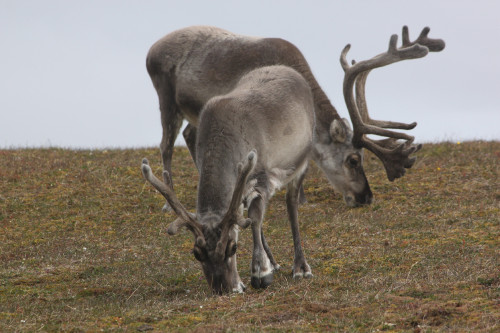
Polar Bear Mother and Cub –
Spitsbergen Arctic Reindeer -
Spitsbergen
One of our hikes took us to the site of a 17th century Dutch whaling
station with its remnants of old blubber pots alongside the graves of over 100
young whalers, who came to the high Arctic in search of their fortune, but
instead paid with their lives. Of course, the whales paid dearly, too. The
great bow whale, the longest lived mammal on earth, which numbered in the tens
of thousands initially, was reduced to near extinction in the course of just two
centuries.
At the most northerly point of our travels around Svalbard, the ship crossed the
80th parallel (80° N. latitude). At that point we were only 600
miles from the North Pole. In fact, if the pole had been a little taller we
might have been able to see it from there. We celebrated with a champagne toast
on the forward deck and a long blast from the ship’s horn.
Our final stop in Svalbard was at a small research settlement at Ny Alesund. It
was from this location that several polar explorers launched their expeditions
from Svalbard - Byrd and Amundsen among them. A short walk outside of town, we
found the rusting pylon from which Roald Amundsen – polar explorer
extraordinaire – launched his airship on the first successful flight over the
North Pole. It was a poignant reminder of the heroic era of polar exploration.
Before leaving home, we’d read a number of books about the polar explorers and
were fascinated by their stories.
Arctic Exploration Ever since Christopher Columbus
discovered that his route to the Orient was blocked by a new and unexpected
continent, the quest for a Northwest Passage – a sea route from the Atlantic to
the Pacific around the New World’s northern extremities – has been the dream of
explorers and adventurers. Drake, Cook and Hudson were among the early
seafarers who joined the search, but it was not until the 19th
century that arctic exploration hit its peak with England leading the way. The
twin arctic quests of the discovering a Northwest Passage and reaching the North
Pole became a matter of great national prestige and pride.
Throughout the 19th century dozens of ships and
hundreds of men ventured into the vast, unexplored Polar Regions. The tales of
their heroic but often ill-fated expeditions provide some of the most thrilling
adventure stories ever written. Perhaps the most well-known was the ill-fated
Franklin expedition in which Sir John Franklin and his 128 man party left
England in 1845 in search of the Northwest Passage and vanished into the Arctic
forever. Over a dozen relief expeditions were launched to find the Franklin
party but they, too, were unsuccessful, resulting in further loss of life. It
was not until 1905 that Roald Amundsen, a Norwegian, would complete the first
successful navigation of the Northwest Passage. Four years later, in 1909,
Robert Peary, an American, claimed the North Pole.
In any discussion of the great polar explorers, we should
not fail to mention our own son-in-law, Whit Jackson who, as a young college
student, spent a summer crossing the high Arctic in a walrus-skin umiak with a
National Geographic expedition team, attempting to retrace the migration route
of the native Thule Inuit people from Alaska to Greenland a thousand years
earlier. Certainly Whit deserves to be included in any panoply of heroic
Arctic explorers.
Today, one hundred years after Amundsen and Peary,
commercial ships make seasonal transits of the Northwest Passage, giant nuclear
submarines patrol the seas below the Arctic ice cap and tourists arrive on giant
ice breakers to have their photos taken at the North Pole. Fast forwarding
another one hundred years, ships may well be traveling in open waters from
Europe to the Far East over the North Pole if current global warming trends
continue.
Greenland.
Our crossing from Norway to Greenland took three days, our route skirting the
southern edge the massive ice cap which covers the polar sea. The ship even
made a non-scheduled detour into the polar sea ice, launching the Zodiacs for an
exciting excursion into the ice filled sea. We spent much of our time on deck
during the crossing looking for whales, sea ice and migrating sea birds as well
as attending lectures from the naturalists on board on marine life, the changing
sea ice and our destination, Greenland. Upon arriving in the coastal waters of
Greenland, we were confronted by floating icebergs and a dense fog bank, which
slowed the ship to six knots and delayed our arrival by a half a day, a reminder
that it is the sea and ice conditions that determine the itinerary in the Arctic
and not any pre-printed schedule.

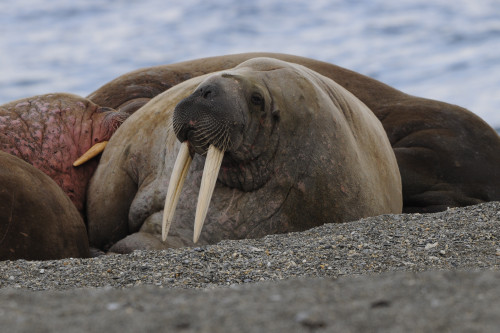
Humpback Whale – Greenland Sea
Walrus - Spitsbergen
Remote, mysterious and extreme, the highly indented and ruggedly mountainous
coast of eastern Greenland is one of the most isolated habitations in the
world. There are only two towns and seven small settlements with a total
population of only 3,500 people along the full length of the 1,600 mile long
East Coast. Trapped between the polar sea ice and the Greenlandic icecap, the
ships can only come and go for five months during the year.
A few bits of information on Greenland and its history that we picked up in our
shipboard lectures: Greenland is the world’s largest island that is not a
continent. Eighty percent of its surface is covered by the Greenland ice sheet
which is, on average, a mile and a half thick. Greenland is the least densely
populated country in the world with a population of just under 60,000 people in
a country the size of Europe. 88% of the population is Inuit; the rest are
Europeans, primarily Danish. Though geographically part of the North American
continent, Greenland has been politically tied to Europe and Denmark for a
thousand years, but has recently been granted virtual independence from Denmark.
Eric the Red, with a shipload of Vikings sailing from Iceland, discovered
Greenland in the 10th century and then returned to Iceland to spread
word about the country they had found. He called it “Greenland” to attract
settlers. His marketing ploy worked; some 4,000 Norse eventually settled in
Greenland. Despite their reputation as ferocious warriors, the Vikings were
essentially farmers, who did a bit of pillaging, plundering and exploring on the
side. Sometime around the Year 1000, Eric’s son, Leif, set out from Greenland
and discovered North America. The Viking settlements continued in Greenland for
four centuries, and then abruptly vanished.
Our destination in Greenland was Scoresby Sound, the largest fjord complex in
the world, extending inland some 140 miles and harboring some the world’s
largest glaciers, which launch more icebergs (and possibly the iceberg that sank
the Titanic) than any other region on the coast. In fact, during the week of
our visit, an island of ice more than four times the size of Manhattan broke off
from a glacier in northern Greenland and began drifting across the Arctic Ocean.
We spent our three days in the fjord on deck watching the parade of icebergs
floating slowly past, some more than a block long and over 200 feet high.
Watching the giant icebergs slip past, we were reminded of a couple of things
which our staff glaciologist had told us. First, only one-eighth of the iceberg
is visible above water, but that being the case, if we were seeing icebergs the
size of large buildings above the surface then the total size of these monster
icebergs below the surface was almost beyond comprehension. And second, since
the glaciers that spawned the icebergs were formed from snow that had fallen
over 10,000 years ago, we were in the presence of some of nature’s finest
prehistoric creations. The experience was both humbling and awe inspiring.
We went ashore several times, including a half-day visit to Ittoqqoortomitt, an
Inuit village of four hundred people at the entrance to the sound, where we had
a chance to wander around the settlement, meet some of the locals and send some
postcards. We made another shore excursion to seek out the elusive musk ox of
Greenland. We spotted what we thought were musk ox in the distance and took a
few photographs but, when we looked at the photos back on the ship, they turned
out to be musk rocks, and not shaggy, pre-historic musk ox that we had hoped
for.
But the most thrilling moments in Scoresby Sound were our zodiac excursions out
among the majestic icebergs. No two icebergs are the same; each new one is more
spectacular than the previous one. The sculpted shapes of the dazzling
icebergs, floating in the mile deep waters of the fjord, with the rugged
mountains and blue skies in the background were a photographer’s delight,
although the true magnificence of these unique works of nature can never be
fully captured on film.
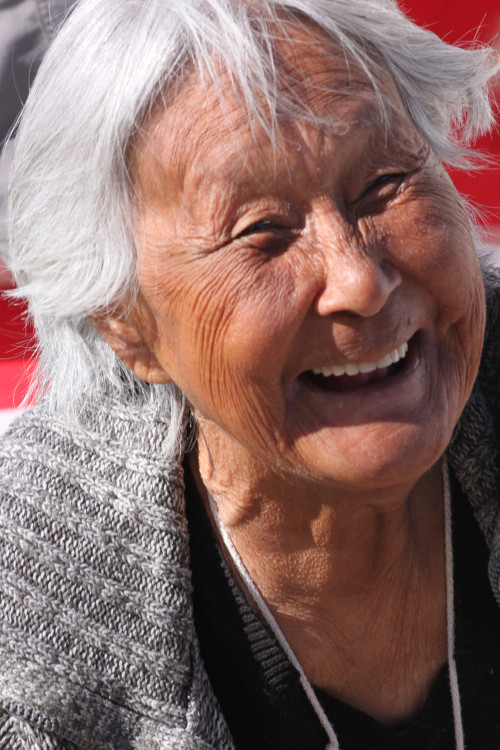
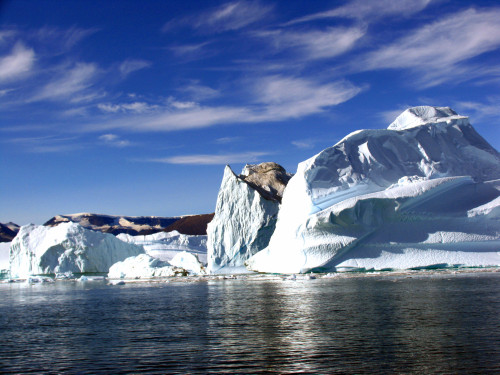

Inuit Woman Scoresby Sound Icebergs – East
Greenland Red Fjord
Our final leg of our 2,100 mile sea voyage was from Greenland to Iceland, where
we spent our last day at sea exploring two volcanic islands in the Westman
Islands just south of Reykjavik. We went ashore in Heimaey, the scene of a
violent volcanic eruption in 1973, which caused the island to be evacuated and
resulted in over half the homes being buried under volcanic ash, earning it the
name “The Pompeii of the North”. The other island was Surtsey, which we had
first flown over 45 years ago as it emerged, bellowing smoke and lava from the
sea - like the beginning of Creation. Access to this pristine island is still
restricted to scientists, who are taking advantage of this unique opportunity to
study the colonization processes of a new land by plant and animal life.
Iceland.
We
first visited Iceland in 1965, a three day layover on the way to our new home in
Italy and have been back on several other occasions through the years. Our
hosts in 1965 were Tom and Hanna Holton, close friends from our Navy days in San
Diego. Tom and I were shipmates on an aircraft carrier. His wife, Hanna, was
the daughter of a master net maker and a 20th generation Icelander, who had come
to California as a nanny, where she met and married Tom.
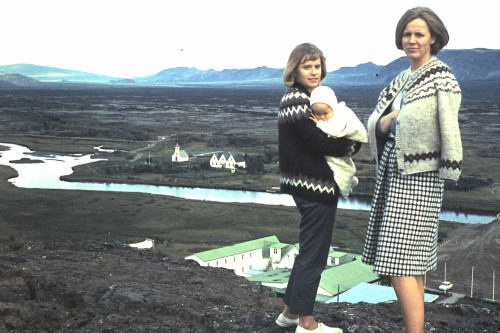

Valerie (and Marnie) and Hanna – Iceland – 1965 Valerie (in
same sweater) and Hanna – Iceland – 2010
Hanna was there to greet us as the Akademic Joffe pulled into the harbor at
Reykjavik. After checking in at our Leif Erikkson hotel, located across the
street from the city’s landmark Hallgrim’s church, the three of us set off to
explore a bit of Iceland. A relatively small country - only 300 miles across
and with a population of just over a quarter of a million people - Iceland is an
easy country to get around and has a wealth of fascinating places to visit.
Driving the Golden Circle route on the first day, we visited the site of the
world’s oldest parliament (930 AD) at Thingvellir; Gullfoss, Iceland’s most
visited waterfall; and the Strokker geyser, which erupts every 5-10 minutes and
may be challenging Old Faithful as the world’s most photographed geyser.
Inspired by the late Bill Holm, a Minnesota author who lived and wrote in
Iceland, we set off the next day to try to find his seaside cottage in Hofsos,
an idyllic fishing village on the Skagafjord, on the rugged North Coast of
Iceland where we stayed overnight. It was a magic place and well worth the
pilgrimage, but the real attraction was the chance to spend three days driving
through Iceland’s spectacular scenic countryside with its treeless, windswept
lava fields and its beautiful valleys, framed by volcanic mountains, dotted with
stone farmhouses and populated with Iceland’s unique breeds of sheep and horses.
We spent our final morning in Reykjavik getting reacquainted with Hanna’s
children and grandchildren before heading for the airport. As we flew out, we
looked down on the recently active
Eyjafjallajökull
volcano, whose eruption had seriously interrupted trans-Atlantic flights several
months earlier. It was quiet once again and no longer a threat to air
travel, although we would not have minded at all if the volcano had forced us to
stay in Iceland a little while longer !!












